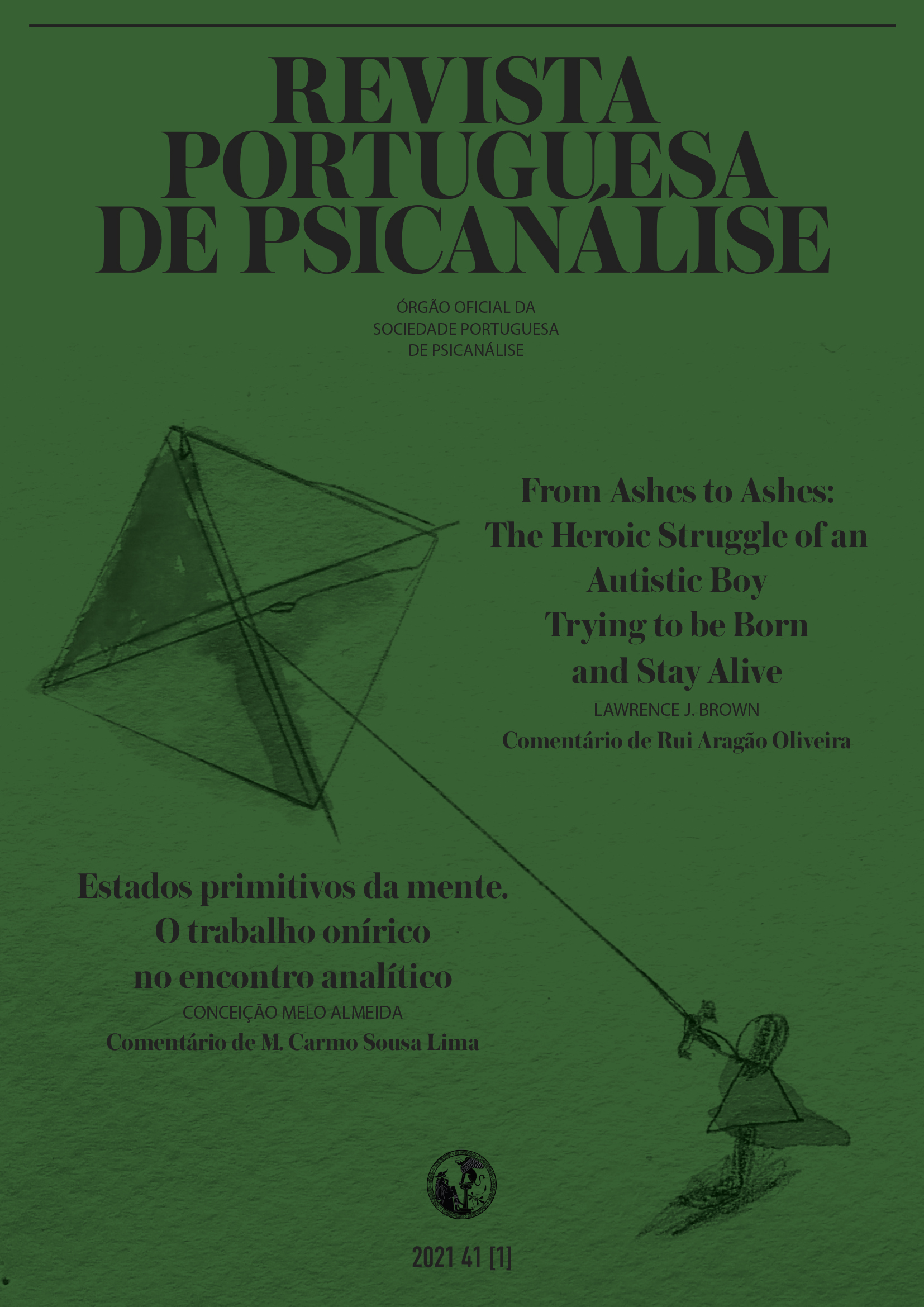From Ashes to Ashes: The Heroic Struggle of an Autistic Boy Trying to be Born and Stay Alive

Resumo
Renascer das cinzas: a luta heróica de um menino autista para nascer e se manter vivo
Este artigo investiga o conceito de autismo psicogénico proposto por Frances Tustin. O trabalho desta psicanalista centra-se na dinâmica desta doença grave e coloca a ênfase nas experiências do bebé no contacto precoce com a mãe. Tustin refere que a interrupção repentina e violenta do contacto pele a pele mãe/bebé dá origem a tentativas patológicas de tratar essa separação, nomeadamente através da autoexclusão da criança do contacto com o mundo emocional externo. Uma extensa vinheta clínica é oferecida para ilustrar como essas dinâmicas se manifestam clinicamente, bem como os esforços do autor para estabelecer uma conexão significativa com o seu jovem paciente. As reações transferenciais e contratransferenciais são discutidas em detalhe.
Palavras-chave
Autismo psicogénico, Frances Tustin, Contacto precoce mãe/bebé, Transferência, Contratransferência
Biografia Autor
Lawrence J. Brown
Membro Titular do Boston Psychoanalytic Institute (BPSI) em Psicanálise de Crianças e Adultos e analista supervisor de crianças. Membro do corpo docente do BPSI e do Massachusetts Institute for Psychoanalysis. Membro do Conselho Editorial da The Psychoanalytic Quarterly e membro fundador do Boston Group for Psychoanalytic Studies.
Referências
- Anzieu, D. (1986) Autistic phenomena and the skin ego, Psychoanalytic Inquiry. 13, 42-48.
- Benton, M. (2003). Wipeout. New Scientist, 178, 38–41.
- Benton, M. (2005) When Life nearly Died. London: Thames and Hudson.
- Bion, W. (1962). Learning from Experience. Heinemann.
- Bion, W. (1965). Transformations. Heinemann.
- Bion, W. (1970). Attention and Interpretation. Heinemann.
- Bion, W. (1992). Cogitations. Karnac Books.
- Bowlby, (1964). Note on Dr Lois Murphy’s paper. International Journal of Psychoanalysis, 45, 44–46.
- Brown, L. J. (2007). On dreaming one’s patient: Reflections on an aspect of countertransference dreams. Psychoanalytic Quarterly, 76, 835–861.
- Brown, L. J. (2011). Intersubjective Processes and the Unconscious: An Integration of Freudian, Kleinian and Bionian Perspectives. New Library of Psychoanalysis Series. Routledge.
- Freud, S. (1923). A seventeenth-century demonological neurosis. In The Standard Edition of the Complete Psychological Works of Sigmund Freud, XIX, 67–106.
- Grotstein, J. (1980). A proposed revision of the psychoanalytic concept of primitive mental states – Part I. Introduction to a newer psychoanalytic metapsychology. Contemporary Psychoanalysis, 16, 479–546.
- Grotstein, J. (1984). A proposed revision of the psychoanalytic concept of primitive mental states, Part II. The borderline syndrome-section 3. Disorders of autistic safety and symbiotic relatedness. Contemporary Psychoanalysis, 20, 266–343.
- Klein, S. (1980). Autistic phenomena in neurotic patients. International Journal of Psychoanalysis, 61, 395–402.
- Korbivcher, C. (2005). The theory of transformations and autistic states. Autistic transformations: A proposal. International Journal of Psychoanalysis, 85, 1595–1610.
- Korbivcher, C. (2014). Autistic Transformations. Karnac Books.
- Meltzer, D. (1975). Adhesive identification. Contemporary Psychoanalysis, 11, 289–310.
- Mitrani, J. (2001). ‘Taking the transference’: Some technical implications in three papers by Bion. International Journal of Psychoanalysis, 82, 1085–1104.
- Mitrani, J. (2011). Trying to enter the long black branches: Some technical extensions of the work of Frances Tustin for the analysis of autistic states in adults. International Journal of Psychoanalysis, 92, 21–42.
- Ogden, T. (1989). On the concept of an autistic-contiguous position. International Journal of Psychoanalysis, 70, 127–140.
- Ogden, T. (2014). Fear of breakdown and the unlived life. International Journal of Psychoanalysis, 95, 205–223.
- Power, D. (2016), The use of the analyst as an autistic shape. International Journal of Psychoanalysis, 97(4), 975–998.
- Rhode, M. (2011). Asperger's syndrome: A mixed picture. Psychoanalytic Inquiry, 31, 288–302.
- Stern, D. (1986). The Interpersonal World of the Infant. Basic Books.
- Tustin, F. (1980). Autistic objects. International Review of Psycho-Analysis, 7(1), 27–39.
- Tustin, F. (1981). Autistic States in Children. Routledge.
- Tustin, F. (1984). Autistic shapes. International Review of Psycho-Analysis, 11, 279–290.
- Tustin, F. (1986). Autistic Barriers in Neurotic Patients. Yale University Press.
- Winnicott, D. (1965). The Maturational Processes and the Facilitating Environment: Studies in the Theory of Emotional Development. Hogarth Press.
- Winnicott, D. (1974), Fear of breakdown. International Review of Psycho-Analysis, 1, 103–107.